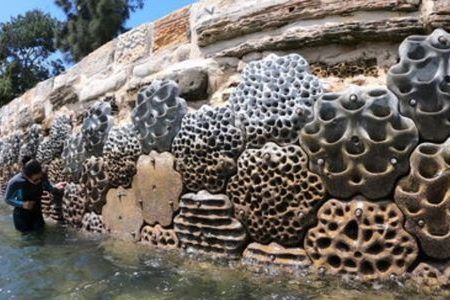Living seawalls make a splash
These 3D-printed panels mimic the natural world to breathe life into marine construction.

These 3D-printed panels combine ecological and engineering expertise to bring marine foreshores back to life.
The way we build in the ocean is ripe for a rethink according to 2021 Earthshot Prize finalist Living Seawalls.
Living Seawalls – a collaboration between marine ecologists at the Sydney Institute of Marine Science and creative designers Reef Design Lab – has developed a series of modular habitat panels in a bid to breathe life back into marine developments around the world.
These panels feature complex surface designs that mimic the natural environment and by doing so provide protective habitats for marine organisms. They can also be added retrospectively to marine construction.
The panels have been shown to improve the ecological credentials of both new and existing foreshore developments, which is timely given the fast-expanding structural presence in our oceans in the form of walls, pilings, pontoons and marinas.
In the United States alone, more than 50 per cent of the natural shorelines have been replaced by seawalls, breakwaters and other artificial, hard structures, according to Living Seawalls.
Globally, built structures now cover 32,000 square kilometres, according to a 2020 study by researchers from the University of Sydney, Australia, and the authors predict this will expand by another 7,300 square kilometres by 2028.
These structures, which are usually flat and featureless, destroy and replace the natural habitats traditionally found in rocky shores, removing the protective refuges and modifying the surrounding sea floor and reducing the diversity of local marine life.
Living Seawalls aims to show that marine construction can also be part of the solution with the use of its panels, which are based on 20 years of scientific research by the Sydney Institute of Marine Life and others.
Living Seawalls currently has ten habitat panel designs, each featuring different features of natural shorelines so as to benefit diverse groups of marine organisms.
These habitat panel designs are 3D printed to maintain accuracy, and from there, concrete panels are cast and can be manufactured in large numbers.
"We’re increasing biodiversity by bringing back missing microhabitats such as rock pools and crevices."

The first Living Seawalls installations were retrofitted into existing seawalls in Sydney Harbour, Australia. Living Seawalls says that its research shows that after one to two years, these seawalls support at least 36 per cent more species than plain, unmodified seawalls. As many as 85 species of invertebrates, seaweeds and fish living can be found living and growing on the panels.
Co-leader of the Living Seawalls project, A/Prof Melanie Bishop, says the aim has been to bring back marine life to the manmade seawalls that make up half of Sydney Harbour’s shoreline.
“More than 50 per cent of the Sydney Harbour shoreline is made up of seawalls and research shows these seawalls do not support biodiversity in the same way as natural shorelines,” she says.
“We’re increasing biodiversity by bringing back missing microhabitats such as rock pools and crevices. These will provide more space for barnacles and seaweeds to live, while small fish, snails and crabs will be able to hide inside the holes and crevices.”
Living Seawalls can now be found at 11 Australian locations, as well as on shorelines in Wales, Gibraltar and Singapore.
It is set to embark on two UK projects, and will expand the Sydney Harbour project supported by a recent A$4.5 million grant from the New South Wales Government.
In another project, the organisation is, in partnership with DP World, installing its modules in Lima – its first in South America.
The new port will include wharf pilings with built-in habitat enhancement structures designed to attract and support a wide variety of marine organisms to create a ‘Living Port’.
In addition to being an Earthshot 2021 finalist, Living Seawalls won the 2022 Banksia Sustainability Award for Biodiversity among other awards.
The tech
Living Seawall panels are first designed digitally by industrial designers at Reef Design Lab who size and shape the features to match the rock pools and crevices found on natural rocky shorelines. Once a panel design is finalised, it is 3D printed, which enables the capture of the fine details of natural shorelines. A reusable mould is then made from the 3D printed panel, and from this, concrete panels can be manufactured in large quantities. Each panel design undergoes a series of tests to ensure it can withstand marine conditions. The panels can be installed bare, or with key species such as oysters or seaweeds attached to their surface to accelerate development of diverse and functional ecological communities. When co-located, habitat units of differing design can achieve multiple outcomes at one site, and the panel design, size and shape can be tailored to the needs of specific locations.
The key players
The Living Seawalls project is a collaboration between marine ecologists at the Sydney Institute of Marine Science and creative designers at Reef Design Lab.
Is it ready to roll
Living Seawalls can be found in several Australian locations as well as in Wales, Gibraltar and Singapore, and will soon be spotted in the UK and South America.





